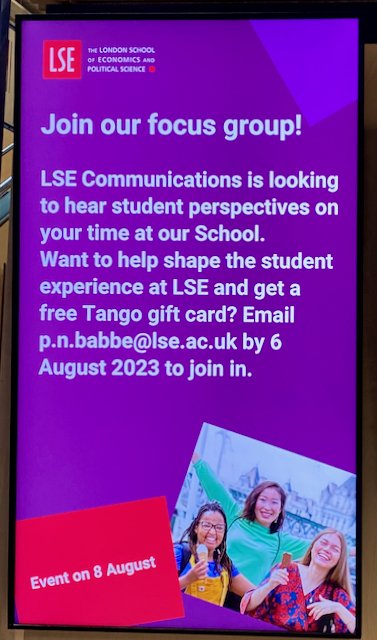I see this as an example of customer co-creation. A consumer who uses a product comes up with an innovative variation, which is then adopted by the company. Also, it does seem as if the company and the consumer ‘get on’ because she’s at a corporate stand promoting the product.
I originally posted this because i needed some place to park the diagram, so that a Kahoot quiz could pick it up!
The photo is useful to stimulate a class whether this has any competition or not.
At LSE this is a useful prompt for discussions around what topics might be covered in the focus group and why.
The FT has these little quizzes about a variety of different brands and they effectively map the journey from lack of awareness to loyalty. No doubt useful in the FTs own efforts to sell advertising and other promotions to potential clients.
So consumers who perceive that a lack of alcohol may also lead to a loss of taste are assured that it won’t. This links to the idea that consumers perceive losses more acutely than gains (of the same size). The picture was taken in the Singapore MRT.
This concept appeared in a number of different guises during the lockdown periods of the coronavirus pandemic. Here’s one application of the concept.
We all know what the benefits are of taking the stairs but we likely don’t know how much. Here’s one way of making the experience feel better.
Fascinating how these people try and diminish the risks that people perceive with radioactivity, note the references to everyday things and make it seem that living next to a nuclear power station is no big deal at all.
An example here of a benefit promised by a business that affects the perceived value at point of purchase but it has to be redeemed by a customer at some future point in time, if they remember to do so.
Tesco is a large UK retailer. Recently a Telecoms business using its name (likely under some commercial agreement) ran an advert on Twitter, trying to compare its pricing against larger telecoms firms.
When consumers started to criticise its pricing on food items, it came back with the following reply.
But, quite rightly, consumers were not convinced. As far as they are concerned, if you have Tesco in your name you sell food and petrol.
A good review of what this is and why firms use it.
Sometimes people are surprised by the use of direct price discrimination in tourism, but it does happen and this example is a useful illustration:
“More than dual-pricing, the new regs set four tiers of rates that can be charged based on a patient’s visa status. Treatment costs are set at four levels: Thai nationals, foreigners from neighboring countries and working foreigners on non-immigrant visas. The fourth group consists of tourists and retirees.”
The following clip from the award winning movie Parasite, shows how Jessica managed the tangibility of her offer. She is tutoring Da-Song and receding a tutor’s fee for the fairly homogeneous and tangible service she provides. In this clip she convinces D Song’s mother of the need to pay for the far more intangible and value added art therapy sessions. The relevant session starts at 43 seconds into the clip
The whole film is worth a watch for the lessons it gives in the use of extrinsic and intrinsic cues and how these are exploited due to consumers’ problems with predictive value and confidence value.
In the clip below see how (small quantities of salad is strategically used to give fast food the ‘halo’ of being healthy (low predictive value vs. high confidence value). And even more cynically grill marks are used to make the fried chicken look healthier than it really is.










